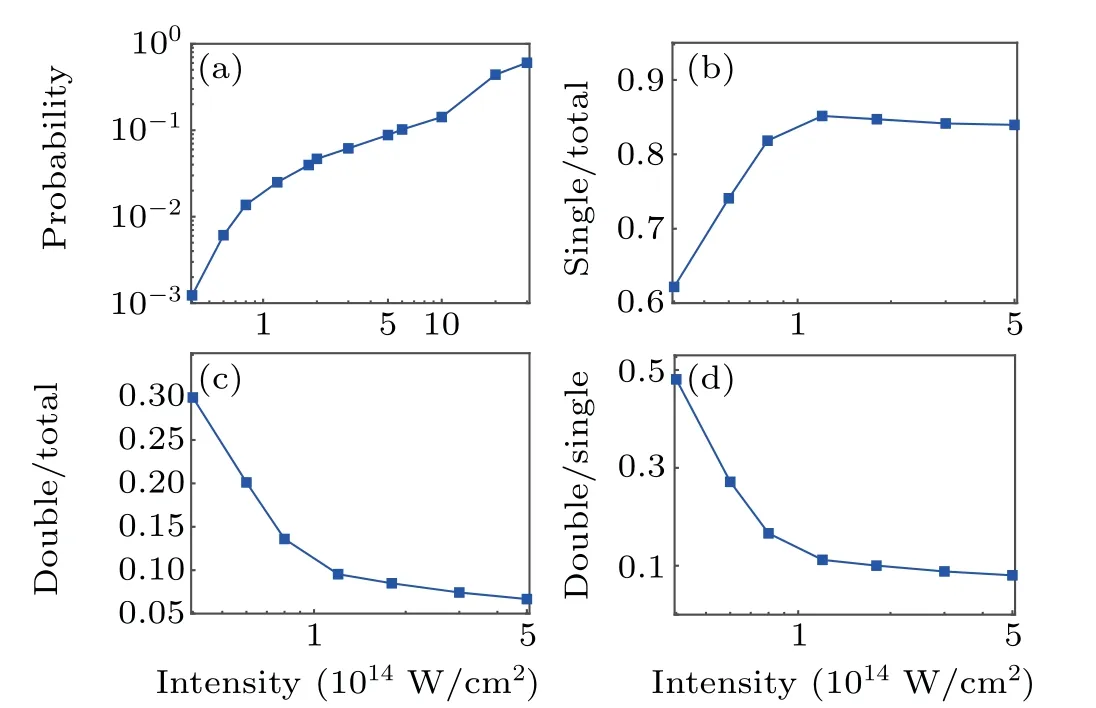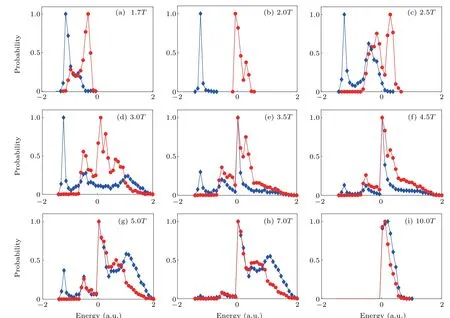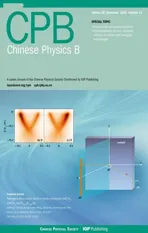Multiple recollisions in nonsequential double ionization below the recollision-ionization threshold∗
2021-12-22XiaoMengMa马晓萌AiHongTong童爱红ZhuoWang王茁andChunYangZhai翟春洋
Xiao-Meng Ma(马晓萌) Ai-Hong Tong(童爱红) Zhuo Wang(王茁) and Chun-Yang Zhai(翟春洋)
1Department of Physics and Mechanical&Electrical Engineering,Hubei University of Education,Wuhan 430205,China
2Institute of Optoelectronic Materials and Components,Hubei University of Education,Wuhan 430205,China
3College of Physics and Electronic Engineering,Xinyang Normal University,Xinyang 464000,China
Keywords: nonsequential double ionization,multiple recollision
1. Introduction
In the past two decades,nonsequential double ionization(NSDI)has been extensively investigated for its responsibility to significantly improve the double ionization yields.[1–6]The phenomenon is attractive because the double ionization yield is measured by many orders of magnitudes enhanced. Many works have been launched in order to study the underlying mechanism and now the widely accepted one as the primary picture is the recollision process: the first ionized electron leaves the nuclear and is driven back by the laser field,causing the direct ionization(RDI)or excitation(RESI)of the second electron through the energy exchange in the recollision.[7–12]It is this kind of interaction that results in the strong correlation between the two ionized electrons.[13]With the development of the ultrafast laser technology,[14–20]the study of NSDI becomes more extensive, and more fancy phenomenons in the correlated electron momentum spectra and sum-energy spectra were found.[21–25]For example,in the experiment on NSDI of helium by laser pulses at relatively low laser intensities,Vlike(finger-like)structure in the correlated momentum distribution was observed.[26]Theoretical studies have shown that both the nuclear attraction and the final-state electron–electron repulsion play important roles.[27]But at high laser intensities,it has been shown that for the V-like structure,the asymmetric energy sharing between the two electrons at recollision is the decisive reason.[28,29]At lower laser intensities, it has been represented that NSDI occurs through doubly excited states and the decay dynamics of the doubly excited states has been detailedly explored by Camuset al.[30]
In the early stage, though it is known that the tunneled electron driven by the oscillating electric field of the linearly polarized laser pulse can return many times to the parent ion,people always regarded only once effective recollision that occurs at the first or the last return or the closest approach. In fact, the recollision picture is more complicate. For example, recent experiments on above threshold ionization have showed that the multiple-recollision event contributes to the low-energy peaks in the photoelectron energy spectrum.[31–34]In NSDI, multiple-recollision have also been already well speculated. For instance,Liu and Yeet al.have discussed that multiple-recollision may be responsible for the observed backto-back emission of the correlated electron pairs for NSDI at low laser intensity.[35,36]They explained the long high-energy tail of the sum-energy spectrum is the consequence of increased number of multiple-recollision trajectories and found the percentage of multiple-recollision trajectories contributing to DI exhibits a significant increasing when the laser intensity reduces from 0.6×1014W/cm2to 0.3×1014W/cm2.In a very recent experiment on NSDI by mid-infrared laser pulse, several small peak structures in the electron momentum spectrum were observed.[37]Associated with the multiple-recollision induced low-energy structures in strong-field above threshold ionization,[33]they are believed to be the symbolization of multiple recollisions in NSDI.But up to now,no clear-cut theoretical study has been performed to demonstrate the multiple recollisions in NSDI.
In this paper,with the three-dimensional(3D)fully classical ensemble model,we discuss the recollision dynamics in NSDI by linearly polarized laser pulses. Via tracing the NSDI trajectories, we find that multiple recollisions have a significant contribution to the NSDI yields when the laser intensity is below the recollision ionization threshold. Because of the multiple energy-exchange from recollisions, the energies of the doubly excited states are higher than those induced by single-recollision trajectories,resulting in the faster DI.As the intensities increases,the time delay distributions of the singlerecollision and multiple-recollision NSDI events tend to be similar. In addition,we investigate the time evolution of each trajectories in NSDI which shows the contribution of multiple recollisions.
2. Method
The 3D classical ensemble model has been introduced for decades[38–41]and widely used in investigating the physical mechanism of NSDI process.[21,22,29,41–49]In this paper, we employ the method proposed by Eberlyet al.to study the underlying recollision processes of NSDI.[38]
In this classical model,the evolution of the three-particle system is determined by the Newton’s equation of motion(atomic units are used throughout until stated otherwise)

To obtain the initial conditions for Eq.(1), the ensemble is populated starting from a classically allowed position for the argon ground-state energy of−1.59 a.u. The available kinetic energy is distributed randomly between the two electrons in the momentum space.Then the system is allowed to evolve for a sufficient long time(100 a.u.) before the laser field is turned on to obtain stable position and momentum distributions.
In our calculations, the ensemble size we perform is 2×106. When the laser field is turned off,we check the energies of both electrons, and the DI event is determined if both electrons achieve positive energies. Here the collision events denote the trajectories which satisfy the condition when the distance between two electronsr12<2.0 a.u. We define the single ionization time as the time when the first electron’s energy achieves positive or the electron is outside the nuclear well, and the energy exchange between the two electrons is not zero. Traveling time indicates the time period between the recollision and the ionization of the recollision electron.
3. Results and discussion
Figure 1(a) shows the NSDI yields that we calculated by 3D absolute classical method, which well reproduces the NSDI featured“knee”structure for argon by linear polarized,780-nm laser pulses. Here we classify the NSDI trajectories according to the times of recollisions. For the trajectories in which returning electrons visit the arear12<2.0 a.u. once,we called them as the single-recollision trajectories and for twice, the double-recollision trajectories. In our calculations,up to five or more recollisions were observed. In addition to the trajectories of once-recollision and twice-recollision,the electron trajectories with three times of recollision contributed the largest. We did not study the trajectories that the electron undergo three or more times of recollisions because the proportion of these trajectories is too small (less than 5%). Figures 1(b)and 1(c)present the proportion of the single-recollision and double-recollision events in the NSDI yield as a function of laser intensity, respectively. In order to observe the transformation of NSDI yield more clearly,we then calculate the ratio of double-recollision events to singlerecollision events and show it in Fig.1(d). It is clearly shown that with the increasing of intensity,the contribution of singlerecollision trajectories to NSDI rises drastically when the intensity is below the recollision-ionization threshold and then the change tends to be gentle when the intensity is greater than 0.4×1014W/cm2. Absolutely opposite to it,the contribution of double-recollision events falls fast and then stays in a near platform state with the intensity increasing. That is to say,at the relatively low intensity, the phenomenon of multiplerecollision will be more distinct. It is easy to understand,because when the laser intensity increases,the recollision energy of the electron raises and thus the recollsion electron just needs one recollision to excite or ionize directly the bound electron.
To intuitively attest the processes stated above,three sample NSDI trajectories selected of electrons are clearly displayed in Fig. 2. In this report, we concentrate on the intensities below the recollision-ionization threshold. We examine the time evolutions of the energies of the two electrons, and the distance between the two electrons and the longitudinal(in the direction parallel to the laser polarization)momentum of each electron,respectively. For the NSDI trajectory shown in the left column,the recollision electron undergo only once collision at the first return at about 2.37T(Tis the laser period),which has been indicated by the cyan arrows.The struck electron thus obtains a quantity of energy from the recollision electron and stays in the excited state for a period of time and then gets ionized by the field, i.e., the RESI is prevalent. In Fig.2(d),after the first ionization of the recollision electron at about 2.8T,the distance between the two electrons suddenly reduce tor12<2.0 a.u. only once. Similarly, the longitudinal momenta of the recollision electron suffers once large sudden decrease after the recollision[in Fig.2(g)]. For the NSDI trajectory shown in the middle column, just before the zero crossing of the laser electric field at about 2.42T, the recollision electron experience the first impact with the struck electron. But the energy transferred is not enough to ionize the struck electron directly,so after the recollision the struck electron stays in an excited state for a period of time. It can be seen that the recollision electron then leave the nuclear and return after about half optical cycle. The struck electron gets ionized by the second recollision merely after the next electric field peak at about 2.84T. This means that the first recollision occurs at the first returning of the recollision electron and the second collision occurs at the second returning. The energy exchange once again makes the bound electron hold enough energy to be ionized,so the time interval between the emission of the bound electron and the last recollision is very short.The NSDI trajectory shown in the right column also undergoes two recollisions, but the second recollisin occurs at the fourth returning after about 1.6Tthan the first recollision. For the two impacts we can see the obviously dramatically changes in the time evolution of the energy, the distance and the longitudinal momenta, which have also been pointed out by the cyan arrows.

Fig. 1. (a) The “knee” structure NSDI yields for linear polarized, 780-nm laser pulses with different intensity. (b) Proportion of the single-recollision events in the total NSDI yield as a function of laser intensity at the wavelength of 780 nm. (c)Proportion of the double-recollision events in the total NSDI yield as a function of intensity at the wavelength of 780 nm. (d)Ratio of double-recollision events to single-recollision events from(b)and(c).

Fig.2. Three illustrative NSDI trajectories selected from single-recollision events and double-recollision events at the intensity of 0.8×1014 W/cm2. There is only one recollision in(a),(d),(g);and two recollisions in(b),(e),(h),(c),(f),(i). The panels from top to bottom show the energies of the two electrons,distance between the two electrons and the longitudinal momenta of each electron versus the time,respectively. The inserted maps in the second row indicate the corresponding amplification. The solid gray lines show the electric field of the laser pulse. The cyan arrows indicate the recollisions.

Fig.3. The panels from top to bottom show the related time distribution at intensity of 0.6,0.8,and 1.2×1014 W/cm2,respectively. Left column: Traveling time for the NSDI trajectories where there is only one recollision. Middle column: Time difference between the first recollision and tunneling ionization(black triangles),the second recollision and tunneling ionization(green squares)for the double-recollision NSDI events. Right column: Time delay between the double ionization and the last recollision for the single-recollision(red squares)and double-recollision(blue triangles)NSDI events,respectively.
In order to obtain a clear physical interpretation of the mechanism properties of the multiple-recollision process, in Fig. 3 we show the correlative time distributions at three different intensities of 0.6, 0.8, and 1.2×1014W/cm2from the top to the bottom, respectively. We use different abbreviated subscripts of time “t” for simplicity that “r” for recollision time, “SI”for the first ionization time of the recollision electron, and “DI” for double ionization time. For the traveling time distribution of the NSDI trajectories where there is only one recollision for the three intensities [Figs. 3(a), 3(d) and 3(g)],the more prominent peaks located at nearly 0.6T,1.7T,and 2.7T,corresponding to the odd order of returning and the smaller peaks located at 1.2Tand 2.2T, corresponding to the even order of returning. As is known,the maximum returning energy of the odd order is always greater than the maximum returning energy of the even order,and the energy of the second returning electron is certainly smaller than 3.17Up(Upis the ponderomotive energy).[50]Thus, for the even order of returns the energy transferred from the recollosion electrons is not competent to ionize or even excite the bound electrons.So the peaks for the multiple-return trajectories are depressed in Figs. 3(a), 3(d), and 3(g). In Figs. 3(b), 3(e) and 3(h), for double-recollision events,the traveling time for the first recollision (black triangles) is about 0.6T. Namely, the first collision occurs mainly at the first returning. Relatively,the traveling time distribution of the second recollisions(green squares)is uniform. At the intensity of 0.6×1014W/cm2[Fig. 3(b)],the second collision occurs mainly at the second returning.But with the increasing of the intensity,the contribution of the later returns grow. This indicates that at the high intensity of 1.2×1014W/cm2[Fig. 3(h)] the velocity of the recollision electron at the second return is fast enough so that interaction between the two electron is weak and the energy exchanged by recollision electron is not enough to directly ionize the struck electron. That results in the failed recollision events and the recollision electron needs a third or more return to transfer enough energy. Figures 3(c), 3(f) and 3(i) present the time delay between the double ionization and the last recollision for the single-recollision and double-recollision NSDI events,respectively. We can see the main peak of time delay distribution for double-recollision events(blue triangles)located at 0.25Tfor the three intensities,which means the two electrons get ionized as soon as the laser electric field reaches the peak.But for single-recollision trajectories,the time delay distribution for different intensities appears diverse. At the intensity of 0.6×1014W/cm2[Fig.3(c)],the main peak is shifted about 0.55T,which is close to the second peak value of the time delay distribution of double-recollision events. For intensity of 0.8×1014W/cm2[Fig.3(f)],the time delay focuses on 0.4T.As the intensity increases to 1.2×1014W/cm2,as is shown in Fig. 3(i), the main peak almost overlaps with the time delay distribution of double-recollision events. The discussed above indicates that the ionization speed of the double-recollision trajectories is higher than that of the single-recollision trajectories. That is not difficult to understand, because the total energy transferred through the twice recollision is higher than that through one recollision. As a result, at low intensity the system is staying at a higher excited state after twice recollisions and the struck electron can escape more easily and fast.However,when the laser intensity increases,the returning energy of the electron is enhanced enough to pay for the excitation energy or ionization energy. Thus no matter there is one or two recollisions,the struck electron could be excited or ionized quickly.

Fig.4. Snapshots of the energy distribution as time evolves from 1.7T to 10.0T of NSDI trajectories selected from single-recollision events. The intensity is 0.8×1014 W/cm2. In order to observe more clearly,we only show the trajectories single ionized at about 1.75T of the sine-shaped field. The red and blue lines indicate the recollision electrons and struck electrons,respectively.
In the following, to describe the energy exchange in the multiple recollision process detailedly, we perform the time evolution of the energies of electron pair belonging to the single-recollision and double-recollision trajectories in Figs.4 and 5, respectively. For simplicity but without loss of generality,we choose the case of 0.8×1014W/cm2. In Fig.4,plot(a)corresponds to the timet=1.7Twhen the recollision electrons begin to single ionization and plot(b)corresponds to the timet=2.0Tthat almost all recollision electrons have been ionized out of the nuclear. According to the recollision picture,the recollision electron returns every half cycle until the DI occurs. At timet=2.5T,the DI trajectories resulted from the first return are clearly presented by the part in which both energies of the two electrons are more than zero.Because most of the time delay for single-collision events is longer than 0.5T[Fig.3(f)],so we can see in plot(c)a part of energy distribution of the recollision electron(red circle lines)and the struck electron(blue diamond lines)is less than zero and more than−0.5, i.e., the doubly excited state, leaving the rest of bound electron which has not undergone impact is still in the bound state.In the classical model,the doubly excited states describe such a picture that the first electron excited the bound electron through the recollision but the recollision electron itself is recaptured,as shown by the classical trajectories in the first row of Fig. 2. Then every about 0.5T, the recollision electrons return to excite or ionize the bound electrons until double ionization. We can see the number of bound electrons decreases gradually. Finally,all the electrons get released[plot(i)].

Fig.5. Same to Fig.4 but for NSDI trajectories selected from double-recollision events.
Comparatively speaking, the time evolution of doublerecollision trajectories in Fig. 5 seems more complex. Even at timet=2.5T, after the first recollision, most of the struck electrons stay in the bound or excited state and scarcely any get ionized. Figure 3(e)shows the time difference between the second recollision, and the tunneling ionization is more than 0.8T. These struck electrons are still in excited state waiting for the second recollision from the recollision electrons’another returning. After another period of traveling time of nearly 0.6T,some pairs of electrons stayed in doubly excited state undergo the second recollision and begin to get ionized at timet=3.5T. Figure 5(f) shows at timet=4.5Tthe remaining bound electrons experience the second recollision at the recollision electrons’third or fourth returns. Through the multiple-recollision process the recollision electrons exchange more energy to the bound ones, increasing the final energy of struck electron and forming the significantly broaden sumenergy spectrum in Fig.5(i).[35]
4. Conclusion
In summary, we revisited the recollision mechanism of NSDI below the recollision-ionization threshold using a linearly polarized driving laser field of 780 nm and found the contribution of multiple recollisions is prevalent at lower intensities. Compared with the single-recollision process, the multiple-recollision promotes the energy exchange from the recollision electron to the bound electron. Thus for multiplerecollision events, the energies of doubly excited states are higher and the DI occurs more quickly than single-recollision trajectories. We also studied the time evolution of energy by tracing trajectories,which provides illustration about the process of multiple recollisions.
杂志排行
Chinese Physics B的其它文章
- Transient transition behaviors of fractional-order simplest chaotic circuit with bi-stable locally-active memristor and its ARM-based implementation
- Modeling and dynamics of double Hindmarsh–Rose neuron with memristor-based magnetic coupling and time delay∗
- Cascade discrete memristive maps for enhancing chaos∗
- A review on the design of ternary logic circuits∗
- Extended phase diagram of La1−xCaxMnO3 by interfacial engineering∗
- A double quantum dot defined by top gates in a single crystalline InSb nanosheet∗
